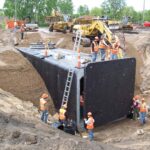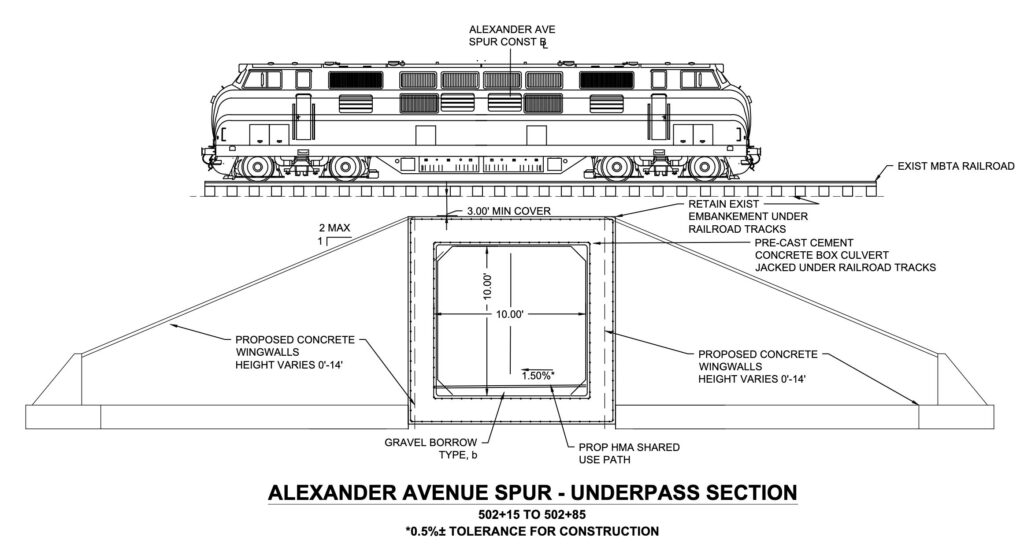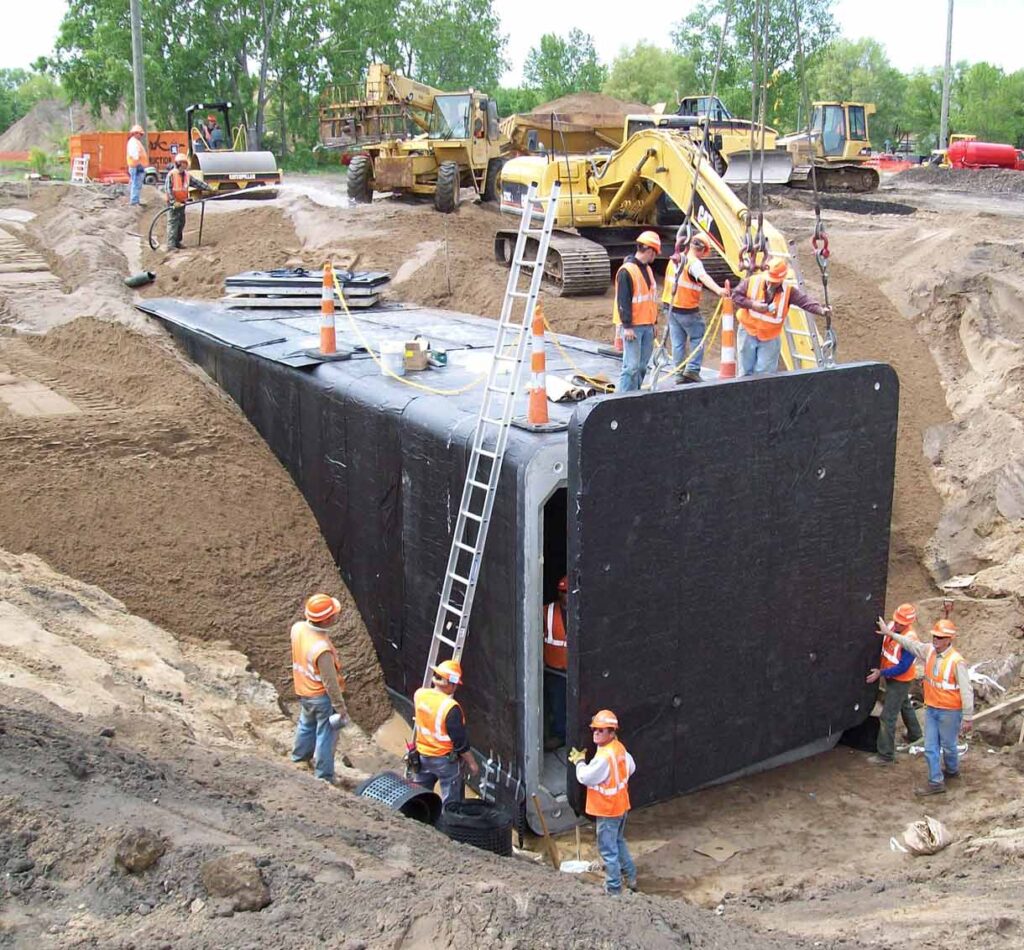
By Vincent Stanton, Jr.
The MBTA recently changed its position regarding the preferred construction method for the new tunnel under the Fitchburg Commuter Rail Line at Alexander Avenue. Now the plan is to use “cut and cover” construction rather than tunnel jacking. The change will lower the cost of constructing the Belmont Community Path by an estimated $5 million, shorten the construction timeline, reduce the construction footprint, and be less disruptive for nearby residents, the Belmont middle-high school community, and Fitchburg Line riders.
The cut and cover approach will also permit a wider tunnel, which is preferable given the anticipated heavy use at school opening and closing times. This change in the construction method is ultimately a win-win for Belmont, MassDOT, and the MBTA, albeit it will delay the completion of project design by a few months because for the past two years a different construction method was planned.
In February 2020, Nitsch Engineering, the firm Belmont hired to design Phase I of the Belmont Community Path, submitted a Conceptual Design Report (CDR) to MassDOT. The CDR outlined design options along the path, and provided Nitsch Engineering’s recommendations for each segment. In March 2020 the Nitsch team, together with Belmont town engineer Glenn Clancy, met with senior MBTA management to review the design options impacting MBTA property.
In the CDR, Nitsch and its subcontractor GZA GeoEnvironmental, a tunnel specialist, recommended that the Alexander Avenue underpass be built using the cut and cover method (also referred to as open excavation). That method entails removing the tracks over the future tunnel, stopping train service, then digging a trench to the depth of the tunnel bottom, dropping a prefabricated tunnel into the trench, then reassembling the layers above.
In the CDR, Nitsch wrote, “open excavation construction offers many advantages over tunnel jacking. Construction costs would be significantly less, as would the amount of land required for construction and staging activities [and it] would lessen impacts to adjacent properties.”
Nonetheless, in March 2020 the MBTA’s chief of railroad operations indicated a strong preference for tunnel jacking as the construction method. According to Nitsch project manager John Michalak’s meeting notes, the MBTA was particularly concerned that imperfect soil compaction over the tunnel following cut and cover construction might lead to future settling of the tracks.
Nitsch of course had to defer to the MBTA’s preferences. Accordingly, 25% design work proceeded on the assumption that the tunnel would be jacked under the tracks, and GZA developed detailed plans for jacking.
Briefly, tunnel jacking would entail excavating two large pits; a jacking pit on the high school side and a receiving pit on the Channing Road side. Powerful hydraulic pumps (jacks) would then be installed in the jacking pit and used to push a prefabricated tunnel into place under the tracks, towards the receiving pit, where displaced earth would be removed. Ideally jacking could be accomplished without disrupting the surface above, so trains could keep running. That is likely what the MBTA had in mind in February 2020.
In November 2021, Nitsch Engineering (on behalf of Belmont) submitted the 25% design package for Phase I of the Community Path to MassDOT, which formally reviews projects at the completion of 25% and 75% design. The review ensures that projects meet the standards necessary to be eligible for state and federal funding via the Transportation Improvement Program (TIP). Following MassDOT sign-off on 25% and 75% designs, the agency holds a public hearing on the project.
In reviewing Belmont’s 25% design, MassDOT noticed, and questioned, the choice of tunnel jacking. That prompted a deeper review of the two construction methods by Nitsch and GZA, including a detailed comparison of the project scope and costs in view of new information about subsoil composition and its implications for each method.
The resulting analysis showed that:
- Because the soil layer between the top of the tunnel and the tracks would only be about 3 feet deep, and the earth below is silty clay, the tracks would not be stable enough to use during conventional tunnel jacking;
- To alleviate that problem would require building a temporary bridge (a “jump span”) over the the tunnel zone,
- Pushing the tunnel into place via hydraulic jacking, then
- Removing the temporary bridge and placing the tracks, ties, and ballast back in their original location.
As a result, railroad service would have to be interrupted twice (vs. only once with the cut and cover method). More important, the cost of jacking was estimated by GZA Geoenvironmental to be about $5 million higher, due in large part to the cost of driving 54 steel piles deep into the ground on either side of the tunnel to support the jump spans for east- and west- bound tracks. GZA estimated that one pile could be driven into the ground each night after the end of Fitchburg Line service (1 AM), so just driving the piles would take two months while producing a nighttime racket for residents!
In view of the new analysis, the MBTA had little choice but to change its position on constructing the underpass—indeed, the original rationale for tunnel jacking evaporated with the requirement for the jump span. At a meeting in April 2023, the MBTA agreed to build the underpass using the cut and cover method, and proposed a four-day Thanksgiving weekend for the project (year to be determined).
Nitsch, GZA, and yet another subcontractor with expertise in project scheduling, WSP, are now finalizing detailed plans for cut and cover construction. This change in plans is expected to delay MassDOT review of the Belmont Community Path 25% design by about two months. While unfortunate, that delay is only one of many—including COVID-19 associated delays—that have pushed back the project development timeline by about 18 months.
Meanwhile, as reported in the January/February 2023 BCF Newsletter, the Boston Region Metropolitan Planning Organization (MPO) voted to fund the Belmont Community Path in federal fiscal year 2026, which starts October 1, 2025. So, while the delays have been aggravating to those involved in the project, Nitsch Engineering has assured the Belmont Community Path Project Committee that there is more than enough time to complete 100% design well before construction funding is available in late 2025.
On balance, the final resolution of the underpass construction method is a positive development for all concerned, not only because it will save an estimated $5 million, but also because it will permit construction of a wider tunnel (14 feet instead of 10 feet with tunnel jacking) better able to accommodate anticipated pedestrian and bicycle traffic, and it will be much less disruptive to residents.
Vincent Stanton, Jr. is a director of the Belmont Citizens Forum. Opinions expressed in this writing are his own.




Sorry, the comment form is closed at this time.